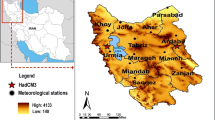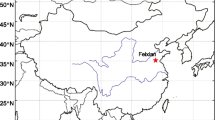Abstract
Regression-based statistical downscaling is a method broadly used to resolve the coarse spatial resolution of general circulation models. Nevertheless, the assessment of uncertainties linked with climatic variables is essential to climate impact studies. This study presents a procedure to characterize the uncertainty in regression-based statistical downscaling of daily precipitation and temperature over a highly vulnerable area (semiarid catchment) in the west of Iran, based on two downscaling models: a statistical downscaling model (SDSM) and an artificial neural network (ANN) model. Biases in mean, variance, and wet/dry spells are estimated for downscaled data using vigorous statistical tests for 30 years of observed and downscaled daily precipitation and temperature data taken from the National Center for Environmental Prediction reanalysis predictors for the years of 1961 to 1990. In the case of daily temperature, uncertainty is estimated by comparing monthly mean and variance of downscaled and observed daily data at a 95 % confidence level. In daily precipitation, downscaling uncertainties were evaluated from comparing monthly mean dry and wet spell lengths and their confidence intervals, cumulative frequency distributions of monthly mean of daily precipitation, and the distributions of monthly wet and dry days for observed and modeled daily precipitation. Results showed that uncertainty in downscaled precipitation is high, but simulation of daily temperature can reproduce extreme events accurately. Finally, this study shows that the SDSM is the most proficient model at reproducing various statistical characteristics of observed data at a 95 % confidence level, while the ANN model is the least capable in this respect. This study attempts to test uncertainties of regression-based statistical downscaling techniques in a semiarid area and therefore contributes to an improvement of the quality of predictions of climate change impact assessment in regions of this type.











Similar content being viewed by others
References
Bray M, Han D, Xuan Y, Bates P, Williams M (2011) Rainfall uncertainty for extreme events in NWP downscaling Model. Hydrological Processes 25:1397–1406
Buytaert W, Vuille M, Dewulf A, Urrutia R, Karmalkar A, Célleri R (2010) Uncertainties in climate change projections and regional downscaling: implications for water resources management. Hydrol Earth Syst Sci Discuss 7:1821–1848
Carter TR, Hulme M, Lal M (IPCC-TGCIA) (1999) Guidelines on the use of scenario data for climate impact and adaptation assessment. Version 1. Task Group on Scenarios for Climate Impact Assessment, p 69
Caldwell P, Chin HNS, Bader DC, Bala G (2009) Evaluation of a WRF dynamical downscaling simulation over California. Clim Change 95:499–521
Dessai S, Hulme M (2001) Climatic implications of revised IPCC emission scenarios, the Kyoto Protocol and quantification of uncertainties. Integrated Assess 2(3):159–170
Dibike Y, Gachon P (2006) Uncertainty analysis of statistical downscaling model outputs from two global climate models in northern Canada. Geophysical Research Abstracts 8:01424
Di Luca A, de Elía R, Laprise R (2011) Potential for added value in precipitation simulated by high-resolution nested regional climate models and observations. Clim Dynam 1–19. doi:10.1007/s00382-011-1068-3
Hsu K, Moradkhani H, Sorooshian S (2009) A sequential Bayesian approach for hydrologic model selection and prediction. Water Resources Research 45:W00B12. doi:10.1029/2008WR006824
Jung I, Chang H, Moradkhani H (2011) Quantifying uncertainty in urban flooding analysis by combined effect of climate and land use change scenarios. Hydrology and Earth System Science 15:617–633
Jung I, Moradkhani H, Chang H (2012) Uncertainty assessment of climate change impact for hydrologically distinct river basins. Journal of Hydrology 466–467:73–87. doi:10.1016/j.jhydrol.2012.08.002
Khan MS, Coulibaly P, Dibike Y (2006) Uncertainty analysis of statistical downscaling methods using Canadian Global Climate Model predictors. Hydrological Processes 20:3085–3104
Levene H (1960) Robust tests for equality of variances. In: Olkin I (ed) Contributions to probability and statistics. Stanford University Press, Stanford, CA, pp 278–292
Madadgar S, Moradkhani H (2011) Drought analysis under climate change using copula. Journal of Hydrologic Engineering. doi:10.1061/(ASCE)HE.1943-5584.0000532
Meehl GA et al (2007) Global climate projections. In: Solomon S (ed) Climate change 2007: the physical basis. Cambridge University Press, Cambridge, UK, pp 747–845
Moradkhani H, Meier M (2010) Long-lead water supply forecast using large-scale climate predictors and independent component analysis. J Hydrologic Engineering 15(10):744–762. doi:10.1061/ASCE-HE.1943-5584.0000246
Moradkhani H, Sorooshian S (2008) General review of rainfall-runoff modeling: model calibration, data assimilation, and uncertainty analysis. In: Sorooshian S, Hsu KI, Coppola E, Tomassetti B, Verdecchia M, Visconti G (eds) Hydrological modeling and water cycle: coupling of the atmospheric and hydrological models, vol 63. Springer, Water Science and Technology Library, pp 1–23
Moradkhani H, Baird RG, Wherry S (2010) Impact of climate change on floodplain mapping and hydrologic ecotones. Journal of Hydrology 395:264–278. doi:10.1016/j.jhydrol.2010.10.038
Najafi M, Moradkhani H, Wherry S (2011a) Statistical downscaling of precipitation using machine learning with optimal predictor selection. Journal of Hydrologic Engineering 16(8):650–664. doi:10.1061/(ASCE)HE.1943-5584.0000355
Najafi M, Moradkhani H, Jung I (2011b) Assessing the uncertainties of hydrologic model selection in climate change impact studies. Hydrologic Processes 25(18):2814–2826. doi:10.1002/hyp.8043
Parrish MA, Moradkhani H, DeChant CM (2012) Toward reduction of model uncertainty: integration of Bayesian model averaging and data assimilation. Water Resour Res. doi:10.1029/2011WR011116
Risley J, Moradkhani H, Hay L, Markstrom S (2011) Statistical trends in watershed scale response to climate change in selected basins across the United States. AMS Earth Interaction 15:617–633
Samadi SZ, Mahdavi M, Sharifi F, Bihamta MR (2009) Methodology for selecting the best predictor for climate change impact assessment in Karkheh Catchment, Iran. J Environ Sci Eng (JESE) 51:249–256
Samadi SZ, Sagareswar G, Tajiki M (2010) Comparison of general circulation models: methodology for selecting the best GCM in Kermanshah synoptic station, Iran. International Journal of Global Warming 2(4):347–365
Samadi S, Carbone GJ, Mahdavi M, Sharifi F, Bihamta MR (2013) Statistical downscaling of river runoff in a semi-arid catchment. 1101 ASCE’s J Water Resour Manag 27:117–136
Sarewitz D, Pielke R, Keykhah M (2003) Vulnerability and risk: some thoughts from a political and policy perspective. Risk Anal 23:805–810
Schneider S (2001) What is ‘dangerous’ climate change. Nature 411:17–19
Semenov MA (2007) Developing of high-resolution UKCUP02-based climate change scenarios in the UK. J Agr Forest Meteol 144:127–138
Sharifi F, Samadi SZ, Wilson CAME (2012) Causes and consequences of recent floods in the Golestan catchments and Caspian Sea regions of Iran. Natural Hazards 61:533–550
Wilby RL, Dawson CW (2007) Using SDSM version 4.2—a decision support tool for the assessment of regional climate change impacts. SDSM User Manual, Climate Change Unit. Environment Agency of England and Wales, UK, p 67
Wilby RL, Hassan H, Hanaki K (1997) Statistical downscaling of hydrometeorological variables using general circulation model output. J Hydrol 205:1–19
Wilby RL, Dawson CW, Barrow EM (2002) SDSM—a decision support tool for the assessment of regional climate change impacts. Environ Model Software 17:147–159
Wilby RL, Tomlinson OJ, Dawson CW (2003) Multi-site simulation of precipitation by conditional resampling. J Climate Res 23:183–194
Wilby RL, Charles SP, Zorita E, Timbal B, Whetton P, Mearns LO (2004) Guidelines for use of climate scenarios developed from statistical downscaling methods. IPCC Task Group on data and scenario support for Impact and Climate Analysis (TGICA). http://ipcc-ddc.cru.uea.ac. uk/guidelines/dgm_no2_v1_09_2004.pdfi
Acknowledgments
We express our gratitude to Climate data office at Iranian Meteorological organization as well as Water Section in Iranian Water Resource Research organization (TAMAB), for contributing historical insight into the original climatic and stream flow data records. Our deepest appreciation goes to Professor Gregory J. Carbone from University of South Carolina for his assistance on appropriate performance and index associated with uncertainty analysis. Our deepest gratitude also goes to Professor Rob Wilby from Loughborough University, UK, for his assistance and advice throughout the SDSM projection. By the same token, we would like to express our gratitude to SDSM and ANN software providers and the Canadian Climate Change Scenarios Network for providing us, free of charge, the HadCM3 and NCEP Reanalysis data.
Author information
Authors and Affiliations
Corresponding author
Rights and permissions
About this article
Cite this article
Samadi, S., Wilson, C.A.M.E. & Moradkhani, H. Uncertainty analysis of statistical downscaling models using Hadley Centre Coupled Model. Theor Appl Climatol 114, 673–690 (2013). https://doi.org/10.1007/s00704-013-0844-x
Received:
Accepted:
Published:
Issue Date:
DOI: https://doi.org/10.1007/s00704-013-0844-x




